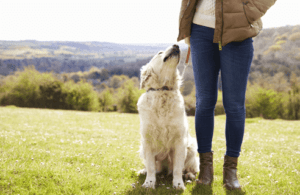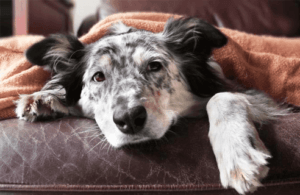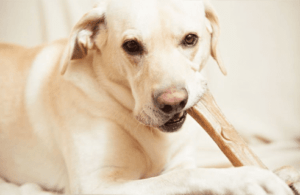We, humans, love to “anthropomorphize” dogs. That means we give them human traits, emotions, and intentions. It’s the only way most of us know how to relate to them and connect with them. We love them like they’re another human. So, we have conversations with them, tell them about our day, buy them treats and toys and dress them up in sweaters. In some ways, it can make us better companions to our dogs, because we are working to emotionally connect with them. However, it’s one thing to give them treats or cuddle with them on the couch. It’s quite another to treat them as if they’re a different species than what they really are, expecting them to think and act the way humans do. Below are 3 ways how to show your dog you love them in a way that will benefit them the most.
Show Your Dog You Love Them With Dog Training
 Early humans saw dogs to be useful for hunting and herding, for an alarm system, and a source of companionship. In return, dogs received companionship, protection, shelter, and a reliable food source. Dogs and humans make for very compatible species. However, the human race has developed greatly since the early domestication of dogs working hard to understand the complex layers of thought and emotion and constantly changing its viewpoint. But, the fact is, dogs haven’t. Dogs operate on a very simple social structure of rank and hierarchy. If the dog knows what is expected of him and has an owner who will guide him, he will follow. If the dog has no one to show him what is expected and what is acceptable behavior, he will not know how to behave. It’s that simple.
Early humans saw dogs to be useful for hunting and herding, for an alarm system, and a source of companionship. In return, dogs received companionship, protection, shelter, and a reliable food source. Dogs and humans make for very compatible species. However, the human race has developed greatly since the early domestication of dogs working hard to understand the complex layers of thought and emotion and constantly changing its viewpoint. But, the fact is, dogs haven’t. Dogs operate on a very simple social structure of rank and hierarchy. If the dog knows what is expected of him and has an owner who will guide him, he will follow. If the dog has no one to show him what is expected and what is acceptable behavior, he will not know how to behave. It’s that simple.
Dog training is the first step in establishing that guidance. Training has a lot to do with teaching your dog to understand commands and respect boundaries. It also a LOT about the human learning how to be the proper guide and advocate for their dog. Once a dog understands their role and expectations and once the human learns how to communicate with the dog, both come away with a clear, uncomplicated view on how to operate together. In turn, dogs feel more secure and confident because they know how to behave. The human feels less anxious and can love on their dog more often for being so well behaved. Dog training is one of the best ways how to show your dog you love them. It gives them security, clarity and, ultimately freedom. We have several dog training programs that can help get this established properly the first time.
Show Your Dog You Love Them By Setting Boundaries
 Humans sometimes try to explain away their dog’s behavior with human traits and often come up with a very complex, human-like explanation for why they do what they do. But dogs are much less complex than many of us give them credit for. Dogs need simple rules and boundaries and to have a leader that puts that structure in place. When we talk with dog owners using the terms “rules” and “boundaries” many of them recoil a bit saying “but, I don’t want to be the bad guy. I want my dog to love me.”
Humans sometimes try to explain away their dog’s behavior with human traits and often come up with a very complex, human-like explanation for why they do what they do. But dogs are much less complex than many of us give them credit for. Dogs need simple rules and boundaries and to have a leader that puts that structure in place. When we talk with dog owners using the terms “rules” and “boundaries” many of them recoil a bit saying “but, I don’t want to be the bad guy. I want my dog to love me.”
Humans often think that the more they give their dog the things that make them happy like sleeping in their bed, giving them treats, or throwing the toy, the more the dog will love them. But, it might surprise you to hear that one of the best ways how to show your dog you love them is by giving them clear and simple boundaries. And, when we say clear and simple, we mean CLEAR AND SIMPLE. Dogs don’t think like humans, so they don’t have complex emotions and reasonings for things. They see the world in black and white both figuratively and literally.
NO GREY AREA
For dogs, things either are allowed or not allowed, there is NO grey area. For example, when your dog is a puppy and they jump up on you for love and cuddles it’s the cutest thing in the world. In fact, you respond with kisses and affection. From that point, your dog has put jumping up into the “allowed” category. When that sweet little puppy grows up and becomes a 100lb dog, jumping up means knocking kids on the floor or scraping up poor Grandma’s legs and it’s a problem. The dog doesn’t know any better. Jumping up is currently in the “allowed” category and if you shout out him to get down or if he gets in trouble for that behavior with no warning, he will be confused and not understand why you are upset.
Another example we see a lot is that sometimes humans want to “treat” their dogs and allow them to do or have something they are normally not allowed like letting them sleep on the bed “just for tonight” or feeding them at the table “just this once”. The truth is, dogs DON’T understand “just for tonight” or “just this once”. When you allow them to do the thing that is normally in the “not allowed” category, you have now placed that thing in the “allowed” category. So when you go into the bedroom the next night and they jump up and get all cozy in your bed – you can’t really be upset with them. The last you told them it was in the “allowed” category. When you set boundaries and you’re consistent with them, you are keeping your dog from being confused and frustrated and that’s actually a great way to show your dog you love them.
Fair Warning – A Lack of Boundaries Can Lead to Resource Guarding
 With a lack of boundaries, many dogs begin to do what we call “resource guarding”. Resource guarding means that a dog has claimed something as theirs. You’ve probably noticed this when a dog is given a treat, like a bone or rawhide – if you try to take it away they may snarl or even nip at you. It’s because they understand that treat to be theirs and they are guarding that treat and letting others know they are NOT going to share. This can happen with beds, couches, objects, dog beds or crates, rooms and even people. If the dog has claimed something as theirs, you can expect that they will see it as their job to keep others from getting to it. To prevent a dog from getting to a place of resource guarding, you need to be very clear about the boundaries you are setting for what is theirs and what isn’t theirs. If you think your dog might be resource guarding, our in-home dog training could be a great option for you. We can retrain that behavior right where it happens.
With a lack of boundaries, many dogs begin to do what we call “resource guarding”. Resource guarding means that a dog has claimed something as theirs. You’ve probably noticed this when a dog is given a treat, like a bone or rawhide – if you try to take it away they may snarl or even nip at you. It’s because they understand that treat to be theirs and they are guarding that treat and letting others know they are NOT going to share. This can happen with beds, couches, objects, dog beds or crates, rooms and even people. If the dog has claimed something as theirs, you can expect that they will see it as their job to keep others from getting to it. To prevent a dog from getting to a place of resource guarding, you need to be very clear about the boundaries you are setting for what is theirs and what isn’t theirs. If you think your dog might be resource guarding, our in-home dog training could be a great option for you. We can retrain that behavior right where it happens.
Show Your Dog You Love Them With Exercise
 For humans, exercise can be a negative activity that sometimes feels like punishment. But, for dogs, exercise is more than just a way to burn calories and keep a healthy weight, it is a form of rewarding work. Just like humans, dogs like to have tasks and “jobs” to do where they feel like they are accomplishing something. For example, some dogs are retrievers, they love to return objects to their owners. They see that as their job and so a great way to exercise a retriever is to take them out for a game of fetch. Another example is a dog who loves to sniff if your dog is constantly sniffing the ground or air it’s not just because they like to smell things, it’s because they’re job is to collect information about their surroundings by sniffing. Taking a “sniffer” out on a walk isn’t just about making sure their body is in motion. It’s that their mind is in motion as they complete their “job” of sniffing everything in site to collect information.
For humans, exercise can be a negative activity that sometimes feels like punishment. But, for dogs, exercise is more than just a way to burn calories and keep a healthy weight, it is a form of rewarding work. Just like humans, dogs like to have tasks and “jobs” to do where they feel like they are accomplishing something. For example, some dogs are retrievers, they love to return objects to their owners. They see that as their job and so a great way to exercise a retriever is to take them out for a game of fetch. Another example is a dog who loves to sniff if your dog is constantly sniffing the ground or air it’s not just because they like to smell things, it’s because they’re job is to collect information about their surroundings by sniffing. Taking a “sniffer” out on a walk isn’t just about making sure their body is in motion. It’s that their mind is in motion as they complete their “job” of sniffing everything in site to collect information.
Show your dog you love them by providing an exercise that satisfies their “job”, breed, age and physical needs. Click here to read more about matching exercise activities with your dog.
We hope this guide on how to show your dog you love them gives you a little more insight as to what love looks like to your dog. Remember, human love is VERY different and even though our dogs may be our “kids”…they are still a different species. Show them you love them in their language and you’ll be certain they understand.
____________
If anything in this article stood out to you and you thought “Oh no! My dog does that!” Don’t worry. We’re here to help. Though some dogs can be stubborn, they can all be trained to learn a better way. Give us a call at 775-800-1011 or email us at info@doggoneamazing.com for more information about our dog training and behavior modification services.
____________
